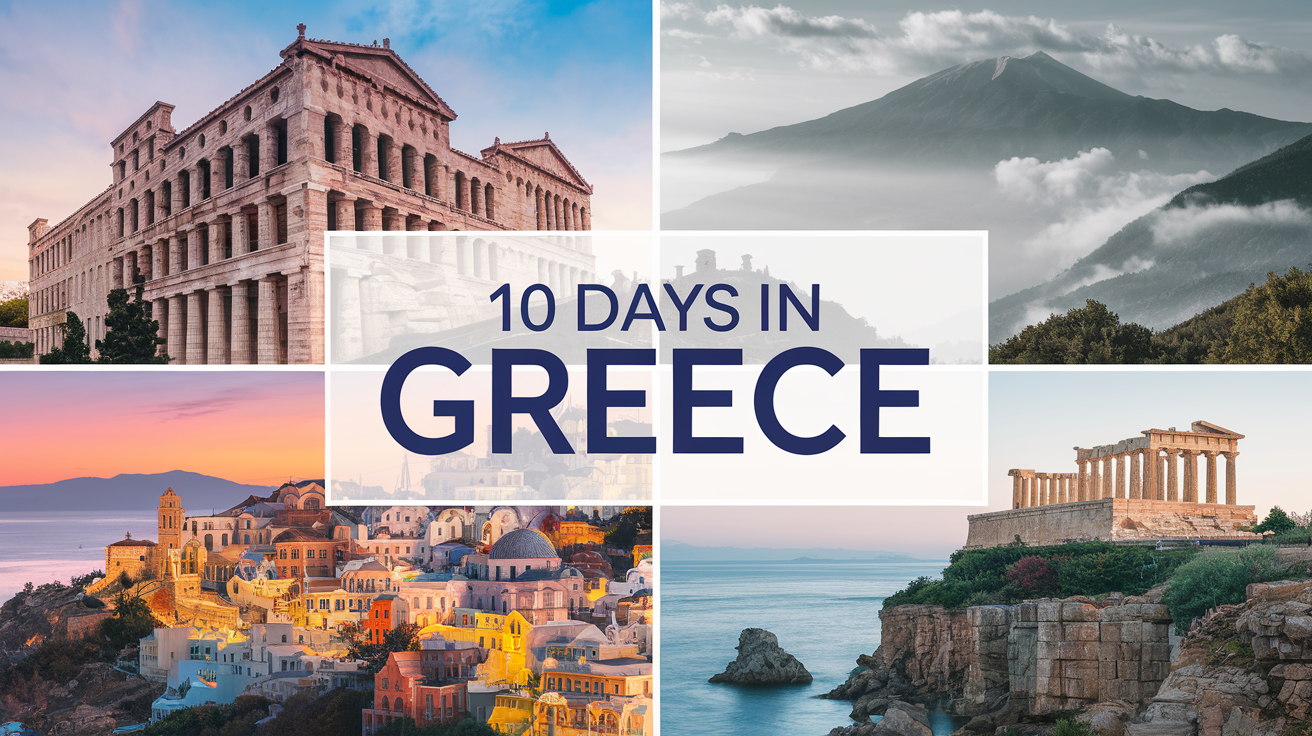Greece is a dream destination where ancient history meets breathtaking landscapes and world-famous islands. If you’ve ever wondered how to explore this diverse country in just 10 days, this blog is your ultimate guide! This itinerary ensures a balanced mix of history, relaxation, culture, and adventure, taking you through Athens, Santorini, Mykonos, Crete, and Meteora.
Day 1-2: Athens – The Cradle of Civilization
Highlights:
Acropolis & Parthenon: Start with Greece’s iconic landmark. Visit early to avoid crowds.
Acropolis Museum: A modern museum housing ancient artifacts.
Plaka and Monastiraki: Stroll through these vibrant neighborhoods with cafes, shops, and street performances.
Temple of Olympian Zeus: Marvel at this colossal ruin, once dedicated to Zeus.
️ Acropolis & Parthenon
- Description: Greece’s most iconic site, the Acropolis stands majestically over Athens, with the Parthenon as its crown jewel.
- History: Built in the 5th century BCE, the Parthenon was a temple dedicated to Athena, the patron goddess of Athens. The Acropolis itself was a citadel and religious center.
- Google Maps: Acropolis of Athens
- ️ Opening Hours:
- Summer: 8:00 AM – 8:00 PM (last entry 7:30 PM)
- Winter: 8:00 AM – 5:00 PM
- Closed on public holidays (e.g., Jan 1, Mar 25, May 1)
- ️ Tickets:
- Full: €20 (April–Oct), €10 (Nov–March)
- Combined ticket (valid for 5 days, includes Ancient Agora, Roman Agora, etc.): €30
- Free Entry: First Sunday of each month (Nov–March), EU students
- Book here: etickets.tap.gr
- ℹ️ Tips for Visitors:
- Visit early morning or late afternoon to avoid crowds and heat.
- Wear comfortable shoes; the marble steps are slippery.
- Bring water and sunscreen.
️ Acropolis Museum
- Description: A modern museum housing priceless artifacts from the Acropolis.
- History: Opened in 2009, the museum showcases over 4,000 objects, including original sculptures from the Parthenon.
- Google Maps: Acropolis Museum
- ️ Opening Hours:
- Monday: 9:00 AM – 5:00 PM
- Tuesday–Sunday: 9:00 AM – 8:00 PM (Fridays until 10:00 PM)
- ️ Tickets:
- Regular: €15 (April–Oct), €10 (Nov–March)
- Book here: theacropolismuseum.gr
- ℹ️ Tips for Visitors:
- Don’t miss the glass floor revealing ancient ruins below.
- Check out the top-floor Parthenon Gallery with stunning city views.
️ Plaka & Monastiraki
- Description: Lively neighborhoods full of neoclassical houses, street music, tavernas, and shops.
- History: Plaka is one of Athens’ oldest districts, with roots stretching back to ancient and Ottoman times.
- Google Maps: Plaka, Monastiraki
- ️ Opening Hours:
- Open-air areas: 24/7
- Shops & cafes: generally open 10:00 AM – 10:00 PM
- ️ Tickets: Free to explore
- ℹ️ Tips for Visitors:
- Great place to buy souvenirs and local crafts.
- Try traditional Greek coffee or souvlaki from street vendors.
- Watch for pickpockets in crowded areas.
️ Temple of Olympian Zeus
- Description: One of the largest temples in ancient Greece, dedicated to Zeus.
- History: Construction began in the 6th century BCE but wasn’t completed until the 2nd century CE by Emperor Hadrian.
- Google Maps: Temple of Olympian Zeus
- ️ Opening Hours:
- Daily: 8:00 AM – 7:00 PM (last admission 6:30 PM)
- ️ Tickets:
- Included in the Acropolis combined ticket (€30)
- Single entry: €8
- Book here: etickets.tap.gr
- ℹ️ Tips for Visitors:
- Visit during golden hour for amazing photography.
- Nearby Hadrian’s Arch is worth a quick look.
Tips:
Use a combo ticket for major archaeological sites.
Stay near Syntagma Square or Monastiraki for easy access to attractions.
Dining Recommendations:
O Thanasis: Try their famous souvlaki.
Brettos: Sip on Greek ouzo or wine in one of the oldest distilleries.
Day 3-4: Santorini – A Romantic Island Escape
Highlights:
Oia’s Sunset: Watch the legendary sunset from the castle ruins.
Black and Red Beaches: Relax on volcanic sand beaches.
Akrotiri Archaeological Site: Explore the ancient Minoan settlement.
Santorini Wineries: Sample local wines at Santo Wines or Venetsanos Winery.
Oia’s Sunset (Castle Ruins)
- Description: The most famous sunset spot in Greece. Visitors gather at the ruins of the old Byzantine Castle to watch the sun dip below the caldera.
- History: Oia has been a key port village since the Byzantine era. The castle was originally built in the 15th century for protection against pirates.
- Google Maps: Oia Castle Sunset Viewpoint
- ️ Opening Hours: Open 24/7, best visited around 30 minutes before sunset.
- ️ Tickets: Free
- ℹ️ Tips for Visitors:
- Arrive early (1–2 hours before sunset) to claim a good spot.
- Bring water, a light jacket, and a camera.
- Explore the charming alleys of Oia before or after the sunset.
️ Black and Red Beaches
️ Perissa & Kamari (Black Sand Beaches)
- Description: Unique volcanic black sand beaches on the southeast coast of Santorini.
- History: Formed from volcanic ash and lava during past eruptions of Santorini’s volcano.
- Google Maps: Perissa Beach, Kamari Beach
- ️ Opening Hours: Open 24/7
- ️ Tickets: Free (sunbeds/umbrellas usually cost €10–€20)
- ℹ️ Tips for Visitors:
- Wear beach shoes — sand gets very hot!
- Perissa is quieter; Kamari has more shops and tavernas.
️ Red Beach (Kokkini Paralia)
- Google Maps: Red Beach
- ℹ️ Tips for Visitors:
- Access involves a short hike from the parking lot.
- Check safety updates — occasional landslide warnings are issued.
Akrotiri Archaeological Site
- Description: A well-preserved Minoan Bronze Age settlement buried under volcanic ash.
- History: Dating back to 1600 BCE, Akrotiri was destroyed by the massive Thera eruption. It is often called the “Pompeii of the Aegean.”
- Google Maps: Akrotiri Archaeological Site
- ️ Opening Hours:
- Summer: 8:00 AM – 8:00 PM
- Winter: 8:00 AM – 3:00 PM
- ️ Tickets:
- Regular: €12
- Combined with nearby archaeological sites: €15
- Free Entry: First Sunday of the month (Nov–March)
- Book here: etickets.tap.gr
- ℹ️ Tips for Visitors:
- Visit with a guide or audio tour for best experience.
- The site is covered, so it’s comfortable even on hot days.
Santorini Wineries
- Description: Santorini is famous for its Assyrtiko grapes and unique volcanic terroir wines.
- Popular Wineries:
- ️ Opening Hours: Most open 10:00 AM – 7:00 PM, but hours may vary.
- ️ Tasting Packages:
- Ranges from €10–€25 depending on the winery and number of wines sampled.
- Some offer guided tours with cheese pairings.
- Book directly via winery websites or local tours on GetYourGuide/Viator.
- ℹ️ Tips for Visitors:
- Try the Vinsanto (sweet wine) and Assyrtiko.
- Santo Wines offers incredible caldera views — great for sunset tastings.
- Book in advance during high season (June–September).
Tips:
Book accommodations in Oia for luxury or Fira for budget-friendly options.
Rent an ATV to explore the island.
Dining Recommendations:
Ammoudi Fish Tavern: Fresh seafood by the sea.
Naoussa Restaurant: Traditional Greek dishes with a stunning view.
Day 5-6: Mykonos – The Island of Glamour
Highlights:
Little Venice: Quaint seaside houses perfect for sunset views.
Windmills of Mykonos: A symbol of the island’s heritage.
Paradise Beach: Famous for parties and crystal-clear waters.
Delos Island: Take a short boat ride to this UNESCO World Heritage Site.
️ Little Venice
- Description: A romantic and photogenic neighborhood where houses are built right on the water’s edge, often with colorful balconies.
- History: Built in the 18th century by wealthy merchants and sea captains. It became an artistic hub and now a prime spot for sunset and cocktails.
- Google Maps: Little Venice
- ️ Opening Hours: Always open; best enjoyed at sunset.
- ️ Tickets: Free
- ℹ️ Tips for Visitors:
- Grab a drink at a waterfront bar like Caprice or Bao’s for iconic views.
- Great for both photography and nightlife vibes.
️ Windmills of Mykonos
- Description: The iconic windmills of Chora are a symbol of Mykonos, overlooking the sea.
- History: Built by the Venetians in the 16th century to mill grain using wind power. There were once over 20; 7 still stand today.
- Google Maps: Kato Mili Windmills
- ️ Opening Hours: Open all day; best views at sunset.
- ️ Tickets: Free (just a viewpoint); inside the restored windmill museum (Boni Mill): €3–€5
- ℹ️ Tips for Visitors:
- Pair with a visit to Little Venice.
- Bring a scarf or hat that can be secured — it gets windy!
️ Paradise Beach
- Description: One of the island’s most famous party beaches with crystal-clear waters and a festive vibe all day long.
- History: Became popular with hippies in the 1960s and has grown into a globally known party destination.
- Google Maps: Paradise Beach
- ️ Opening Hours: 24/7 (beach), beach clubs usually 10:00 AM – late
- ️ Tickets:
- Entry: Free
- Sunbeds: €20–€50 depending on club (Tropicana, Paradise Club, etc.)
- Party events may charge cover fees (€20–€50)
- ℹ️ Tips for Visitors:
- Go early for swimming, stay late for the party.
- Consider other beaches like Super Paradise if you prefer fewer crowds but similar vibes.
️ Delos Island
- Description: A sacred archaeological island and UNESCO World Heritage Site, said to be the birthplace of Apollo and Artemis.
- History: Delos was a religious and commercial center during the ancient Greek and Roman periods. The island has temples, mosaics, and ancient homes.
- Google Maps: Delos Island
- ️ Opening Hours:
- April–Oct: 8:00 AM – 3:00 PM (closed on Mondays)
- Ferries leave in the morning and return mid-afternoon.
- ️ Tickets:
- Museum Entry: €8
- Ferry Ticket (from Mykonos Old Port): €20–€50 roundtrip
- Guided tours available from GetYourGuide, Viator, or local kiosks
- ℹ️ Tips for Visitors:
- Wear a hat and sunscreen – no shade on the island.
- Bring water and snacks.
- Don’t miss the Terrace of the Lions and House of Dionysus.
Tips:
Stay in Mykonos Town for vibrant nightlife.
Visit Paradise Beach during the day for a calmer experience.
Dining Recommendations:
Kastro’s: Known for its Instagram-worthy views and Greek cuisine.
Scorpios: A bohemian-style beach club with Mediterranean dishes.
Day 7-8: Crete – A Land of Myths and Beaches
Highlights:
Palace of Knossos: Explore the ancient Minoan civilization.
Samaria Gorge: Hike this stunning natural wonder.
Elafonissi Beach: Famous for its pink sand and turquoise waters.
Chania Old Town: Wander through the Venetian harbor and charming alleys.
Palace of Knossos
- Description: The largest Bronze Age archaeological site on Crete and the legendary home of King Minos and the Minotaur labyrinth.
- History: Dating back to 1900 BCE, Knossos was the political and cultural center of Minoan civilization.
- Google Maps: Knossos Palace
- ️ Opening Hours:
- Summer: 8:00 AM – 8:00 PM
- Winter: 8:00 AM – 5:00 PM
- ️ Tickets:
- Regular: €15
- Combined ticket (Knossos + Archaeological Museum of Heraklion): €20
- Free Entry: First Sunday of the month (Nov–March)
- Book here: etickets.tap.gr
- ℹ️ Tips for Visitors:
- Go early to avoid heat and crowds.
- Hire a guide or audio tour to understand the site’s mythological significance.
️ Samaria Gorge
- Description: One of Europe’s longest and most dramatic gorges, offering an exhilarating 16 km hike through stunning scenery.
- History: Declared a national park in 1962 to protect rare flora and fauna like the Cretan wild goat (kri-kri).
- Google Maps: Samaria Gorge Entrance – Xyloskalo
- ️ Opening Hours:
- May–Oct: 7:00 AM – 3:00 PM (closed during bad weather)
- ️ Tickets:
- Entry fee: €5
- Best done as a guided day tour from Chania or Heraklion
- ℹ️ Tips for Visitors:
- The full hike is from Xyloskalo to Agia Roumeli (16 km, 5–7 hours).
- Wear good hiking shoes and carry water/snacks.
- You return by ferry and bus — plan logistics in advance.
️ Elafonissi Beach
- Description: Known for its pink sand, clear turquoise waters, and shallow lagoons — one of the most beautiful beaches in Greece.
- History: Once a secret paradise, Elafonissi is now a protected Natura 2000 reserve.
- Google Maps: Elafonissi Beach
- ️ Opening Hours: Open 24/7 (best during daylight)
- ️ Tickets: Free
- ℹ️ Tips for Visitors:
- Bring your own umbrella or arrive early to rent one (€10–€15).
- There are canteens nearby but consider packing snacks.
- Be mindful of windy days — sand can be harsh.
️ Chania Old Town
- Description: A charming blend of Venetian, Ottoman, and Greek architecture surrounding a vibrant harbor.
- History: Once ruled by Venetians (13th–17th century), then the Ottomans — its architecture reflects this diverse past.
- Google Maps: Chania Old Town
- ️ Opening Hours: Always open; shops usually 10:00 AM – 10:00 PM
- ️ Tickets: Free to explore
- ℹ️ Tips for Visitors:
- Visit the Venetian Lighthouse and Maritime Museum.
- Enjoy dinner or drinks at harbor-front tavernas.
- Great for shopping local crafts and olive oil products.
Tips:
Rent a car for flexible travel around Crete.
Stay in Chania or Heraklion depending on your itinerary focus.
Dining Recommendations:
Tamam Restaurant (Chania): Traditional Cretan cuisine.
Peskesi (Heraklion): Farm-to-table dining with local ingredients.
Day 9-10: Meteora – Monasteries in the Sky
Highlights:
Monasteries: Visit Great Meteoron and Varlaam, perched atop massive rock formations.
Hiking Trails: Walk the trails for the best views of the monasteries.
Sunrise and Sunset Points: Capture the ethereal beauty of Meteora during golden hours.
️Monasteries of Meteora
(Great Meteoron & Varlaam Monasteries)
- Description: Dramatic monasteries perched on towering rock pillars, offering spiritual serenity and surreal scenery.
- History: Built between the 14th–16th centuries by monks seeking isolation. Meteora means “suspended in the air.”
- Google Maps:
- ️ Opening Hours (approximate and subject to seasonal changes):
- Great Meteoron: 9:00 AM – 3:00 PM, closed Tuesdays
- Varlaam: 9:00 AM – 4:00 PM, closed Fridays
- ️ Tickets:
- €3 per monastery (cash only at entrance)
- No online booking required
- ℹ️ Tips for Visitors:
- Modest dress is required (skirts for women, long pants for men; shawls and wraps usually provided).
- There are many stairs — wear comfortable shoes.
- Combine 2–3 monasteries in a day with hiking or by car/tour.
Hiking Trails in Meteora
- Description: Scenic trails connecting the monasteries and viewpoints through lush forests and rocky terrain.
- History: Ancient trails once used by monks and locals for access between rock formations and religious retreats.
- Google Maps:
- ️ Opening Hours: Trails are open year-round; best during daylight.
- ️ Tickets: Free
- ℹ️ Tips for Visitors:
- Start from Kastraki or Kalabaka village.
- Bring water, a hat, and proper footwear.
- Join a guided tour if you want storytelling along the way.
Sunrise and Sunset Points
- Description: Breathtaking golden-hour views over the rock formations and monasteries — perfect for photography and reflection.
- History: These views inspired centuries of spiritual retreat and artistic expression by monks and travelers alike.
- Best Viewpoints:
- ️ Best Time:
- Sunrise: Around 6:00–7:00 AM
- Sunset: Around 8:00–9:00 PM (summer)
- ️ Tickets: Free
- ℹ️ Tips for Visitors:
- Arrive 30–45 minutes before sunset to secure a spot.
- Bring a flashlight or phone light for your descent.
- Be respectful of quietude — it’s a spiritual place.
Tips:
Stay in Kalambaka or Kastraki for proximity.
Wear comfortable shoes for exploring the monasteries.
Dining Recommendations:
Panellinion: A cozy spot for authentic Greek food.
Meteora Restaurant: Local specialties like moussaka and lamb.
How to Travel Between Destinations
Athens to Santorini: Flight (50 minutes) or ferry (5-8 hours).
Santorini to Mykonos: High-speed ferry (2-3 hours).
Mykonos to Crete: Ferry (4-6 hours).
Crete to Meteora: Flight from Heraklion to Athens, then train (5 hours) or drive.
Meteora to Athens: Train (4-5 hours) or drive (4 hours).
Budget Breakdown
Accommodation: €30-€500 per night.
Food: €20-€50 per day for meals.
Transportation: €50-€150 (domestic flights, ferries, and car rentals).
Attractions: €10-€20 per entry ticket.
Packing Essentials
Comfortable walking shoes for ancient ruins and hiking.
Lightweight clothing for the summer and layers for evenings.
Swimwear and beach essentials.
A universal power adapter and travel insurance.
Conclusion
This 10-day itinerary offers the perfect blend of Greece’s rich history, island charm, and natural wonders. Whether you’re watching the sunset in Santorini, partying in Mykonos, or hiking in Meteora, this trip will leave you with unforgettable memories. Start planning your Greek adventure today, and let the beauty of this Mediterranean gem captivate you!
Call-to-Action:
Have you visited Greece or planning to? Share your thoughts and questions in the comments below! Don’t forget to subscribe for more travel inspiration.




